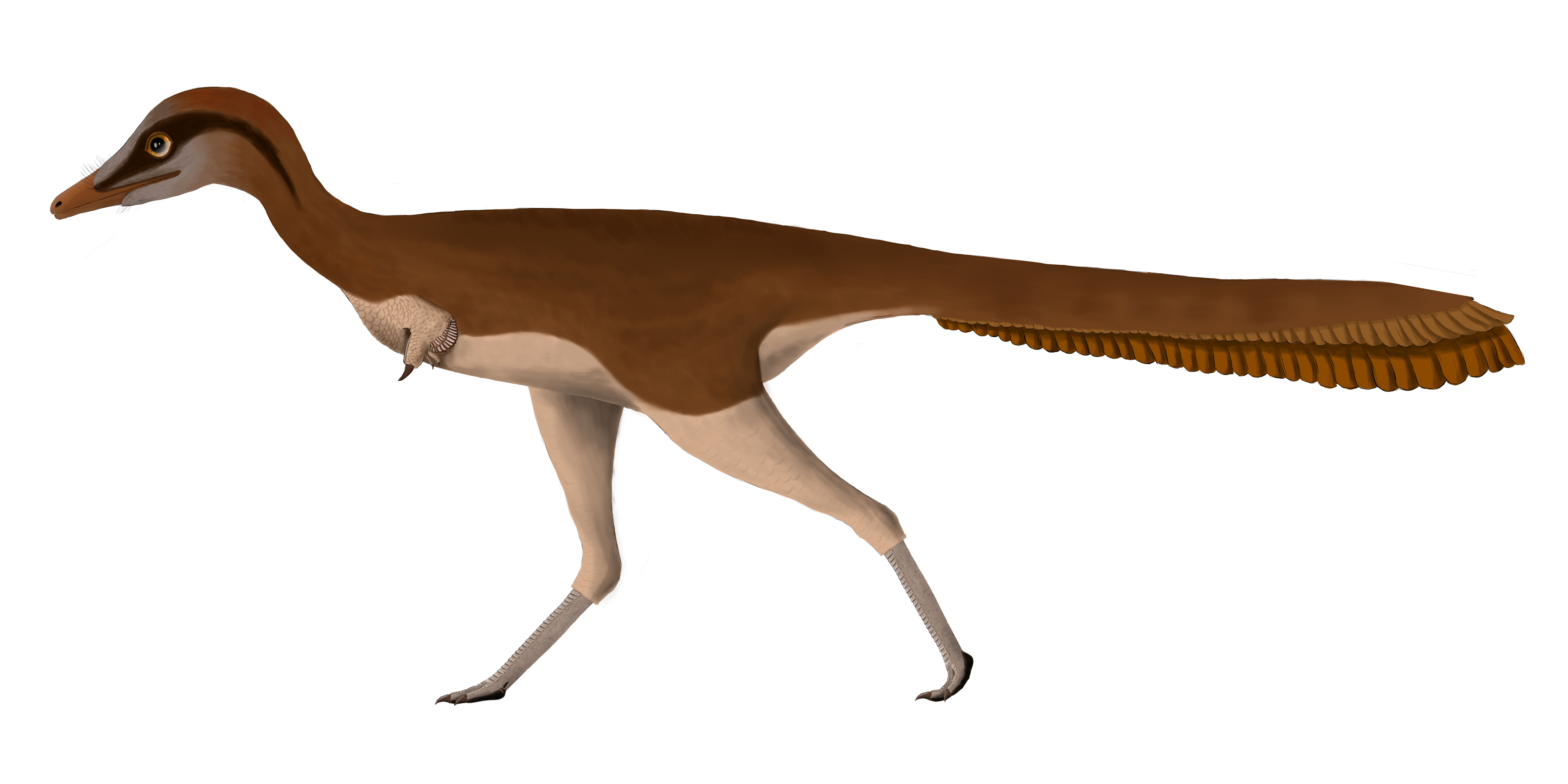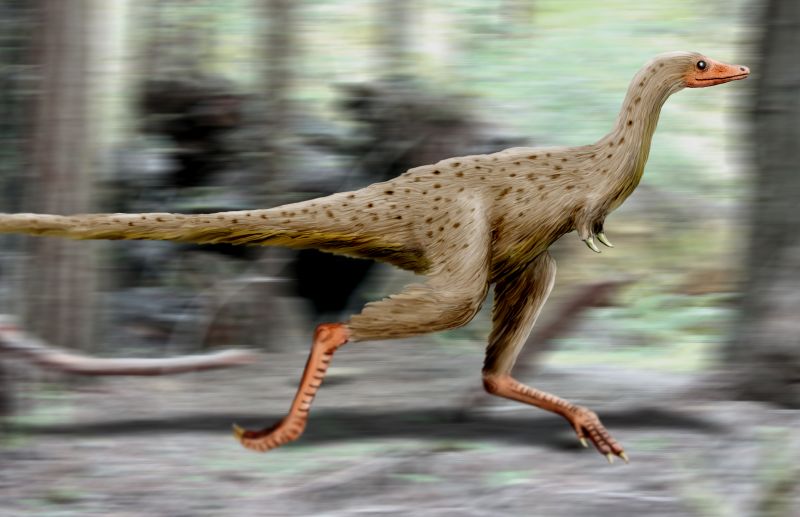|
Alvarezsauridae
Alvarezsauridae is a family of small, long-legged dinosaurs. Although originally thought to represent the earliest known flightless birds, they are now thought to be an early diverging branch of maniraptoran theropods. Alvarezsaurids were highly specialized. They had tiny but stout forelimbs, with compact, bird-like hands. Their skeletons suggest that they had massive breast and arm muscles, possibly adapted for digging or tearing. They had long, tube-shaped snouts filled with tiny teeth. They have been interpreted as myrmecophagous, adapted to prey on colonial insects such as termites, with the short arms acting as effective digging instruments to break into nests. ''Alvarezsaurus'', the type genus of the family, was named for the historian Gregorio Álvarez. History of study Bonaparte (1991) described the first alvarezsaurid, ''Alvarezsaurus calvoi'', from an incomplete skeleton found in Patagonia, Argentina. Bonaparte also named a family, Alvarezsauridae, to contain it. He a ... [...More Info...] [...Related Items...] OR: [Wikipedia] [Google] [Baidu] |
Patagonykus
''Patagonykus'' (meaning "Patagonian claw") is a genus of theropod dinosaur from the Upper Cretaceous of Argentina. This alvarezsauroid was discovered in exposures of the Portezuelo Formation (Turonian-Coniacian) of the Rio Neuquén Subgroup in the Neuquén Basin, Neuquen Province of Patagonia, Argentina. The holotype consists of an incomplete but well-preserved skeleton, lacking a skull, but including many vertebrae, the coracoids, a partial forelimb, pelvic girdle, and hindlimbs. ''Patagonykus'' has been classed with the Alvarezsauridae, a family which includes such taxa as the Mongolian ''Mononykus'' and the Argentinian ''Alvarezsaurus''. In 2010 Gregory S. Paul estimated its length at 1 meter (3.3 ft) and its weight at 3.5 kg (7.7 lbs). Classification Agnolin ''et al.'' (2012) originally placed ''Patagonykus'' within Alvarezsauridae, within the clade Patagonykinae as sister taxon to ''Bonapartenykus''. Makovicky, Apesteguía and Gianechini (2012) found it to be in a polytomy w ... [...More Info...] [...Related Items...] OR: [Wikipedia] [Google] [Baidu] |
Bonapartenykus
''Bonapartenykus'' (meaning "José F. Bonaparte's claw") is a monospecific genus of alvarezsauroid dinosaur from Argentina that lived during the Late Cretaceous (Campanian-Maastrichtian) in what is now the upper Allen Formation of the Río Negro Province. The type and only species, ''Bonapartenykus ultimus'', is known from a nearly articulated but partial skeleton that was found in close association to two incomplete eggs and several clusters of eggshells belonging to the oogenus ''Arriagadoolithus''. ''Bonapartenykus'' was named in 2012 by Federico L. Agnolin, Jaime E. Powell, Fernando E. Novas and Martin Kundrát. ''Bonapartenykus'' has an estimated length of and weight of , making it the largest member of the clade Alvarezsauroidea. Discovery and Naming A partial skeleton of a theropod with eggs was collected in a surface of approximately 30 m2 in fluvial sandstones of the upper Allen Formation in northwestern Patagonia, Argentina. The locality has also produced specimens o ... [...More Info...] [...Related Items...] OR: [Wikipedia] [Google] [Baidu] |
Ceratonykus
''Ceratonykus'' (meaning "horned claw") is a monospecific genus of alvarezsaurid dinosaur from Mongolia that lived during the Late Cretaceous (late Campanian stage, 72.1 Ma) in what is now the Barun Goyot Formation. The type and only species, ''Ceratonykus oculatus'', is known from a fragmentary skeleton, including an incomplete skull, of an adult individual. It was named and described in 2009 by Vladimir Alifanov and Rinchen Barsbold. Its describers questioned the traditional placement of alvarezsaurs in Theropoda, instead suggesting they were ornithischians, but this has not been accepted since. ''Ceratonykus'' has an estimated length of 75 centimetres (2.5 feet) and weight of 760 grams (1.68 lbs). It has been considered as a possible junior synonym of ''Parvicursor''. Discovery and naming In 2003, a partial skeleton of an alvarezsaurid was discovered in the Barun Goyot Formation of the Khermiin Tsav locality, Mongolia by the Paleontological Center of the Mongolian Academy of ... [...More Info...] [...Related Items...] OR: [Wikipedia] [Google] [Baidu] |
Ondogurvel
''Ondogurvel'' () (meaning "egg lizard") is a genus of alvarezsaurid dinosaur from the Late Cretaceous (Campanian) Barun Goyot Formation in southern Mongolia. The type and only species is ''O. alifanovi'', known from a partial skeleton consisting of fragments of two last dorsal vertebrae, three anterior sacral vertebrae, right ilium, left and right pubis and ischium, articulated right tibia, fibula, metatarsals II and IV, and phalanges IV-1 and IV-2, right carpometacarpus, left and right manual phalanx II-1, right femur, left pedal phalanx II-1, and fragments of unidentified phalanges. Discovery and naming In 2022, the type species ''Ondogurvel alifanovi'' was named and described by Alexander O. Averianov and Alexey V. Lopatin. The generic name, "''Ondogurvel''" combines the Mongolian words өндөг “ondo” (), meaning egg, and гүрвэл “gurvel” (), meaning lizard. The specific name, "''alifanovi''" () honors the late Russian paleontologist Vladimir Alifanov who fou ... [...More Info...] [...Related Items...] OR: [Wikipedia] [Google] [Baidu] |
Albertonykus
''Albertonykus'' (meaning "Alberta claw") is an alvarezsaurid dinosaur from the Maastrichtian-age (Upper Cretaceous) rocks of the Horseshoe Canyon Formation of Alberta, Canada. It is known from forelimb and hindlimb remains from multiple individuals. All but two of the specimens come from a bonebed dominated by ''Albertosaurus'', located at the top of Unit 4 of the Horseshoe Canyon Formation,Larson, D. W., Brinkman, D. B., & Bell, P. R. (2010). Faunal assemblages from the upper Horseshoe Canyon Formation, an early Maastrichtian cool-climate assemblage from Alberta, with special reference to the Albertosaurus sarcophagus bonebed This article is one of a series of papers published in this Special Issue on the theme Albertosaurus. Canadian Journal of Earth Sciences, 47(9), 1159-1181. dating to ~68.5 million years ago. ''Albertonykus'' is interpreted as having fed on wood-nesting termites because the forelimbs appear specialized for digging, but are too short for burrowing. ''Alber ... [...More Info...] [...Related Items...] OR: [Wikipedia] [Google] [Baidu] |
Xixianykus
''Xixianykus'' is a genus of alvarezsaurid theropod dinosaur from the late Cretaceous period of China.Xu, X., Wang, D.Y., Sullivan, C., Hone, D.W.E., Han, F.L., Yan, R.H. and Du, F.M. (2010). "A basal parvicursorine (Theropoda: Alvarezsauridae) from the Upper Cretaceous of China.". ''Zootaxa'', 2413: 1-19. Discovery and naming The fossil, holotype XMDFEC V0011, was found in the Majiacun Formation in Henan Province, China. The fossil consists of a partial skeleton, without the skull. Parts of the hind legs, pelvis and spine has also been recovered. ''Xixianykus'' is among the oldest of the derived alvarezsauroids, the parvicursorines, dated to the Santonian– Coniacian, as opposed to other parvicursorines, which are either Campanian or Maastrichtian.Hone, D. (2010)''Xixianykus zhangi'' - A New AlvarezsaurDave Hone's Archosaur Musings, April 23, 2011. The type species is ''Xixianykus zhangi'' described in 2010 by Xu Xing. The genus name refers to Xixia County and to the Greek w ... [...More Info...] [...Related Items...] OR: [Wikipedia] [Google] [Baidu] |
Theropod
Theropoda (; ), whose members are known as theropods, is a dinosaur clade that is characterized by hollow bones and three toes and claws on each limb. Theropods are generally classed as a group of saurischian dinosaurs. They were ancestrally carnivorous, although a number of theropod groups evolved to become herbivores and omnivores. Theropods first appeared during the Carnian age of the late Triassic period 231.4 million years ago ( Ma) and included all the large terrestrial carnivores from the Early Jurassic until at least the close of the Cretaceous, about 66 Ma. In the Jurassic, birds evolved from small specialized coelurosaurian theropods, and are today represented by about 10,500 living species. Biology Diet and teeth Theropods exhibit a wide range of diets, from insectivores to herbivores and carnivores. Strict carnivory has always been considered the ancestral diet for theropods as a group, and a wider variety of diets was historically considered a characteri ... [...More Info...] [...Related Items...] OR: [Wikipedia] [Google] [Baidu] |
Mononykus
''Mononykus'' ( , sometimes ; meaning "one claw") is a genus of alvarezsaurid dinosaur that lived during the Late Cretaceous in what is now Asia on the Nemegt Formation, about 70 million years ago. ''Mononykus'' was a very small theropod, estimated around in length with a weight of . As in ''Shuvuuia'', ''Mononykus'' likely developed a shaggy feathering. It was lightly built with long, thin legs and highly reduced and specialized forelimbs that were likely used for foraging termite mounds or other insect colonies. History of discovery ''Mononykus'' is represented by a single holotype specimen, catalog number MPC-D 107/6 (formerly IGM 107/6). It was collected in 1987 from the Bügiin Tsav locality of the Nemegt Formation, Gobi Desert. This specimen consists of a partial skeleton lacking a tail, and only small fragments of skull bones, including a complete braincase. ''Mononykus'' was originally named ''Mononychus'' in 1993, but later that year, it was renamed because the origin ... [...More Info...] [...Related Items...] OR: [Wikipedia] [Google] [Baidu] |
Shuvuuia
''Shuvuuia'' is a genus of bird-like theropod dinosaur from the late Cretaceous period of Mongolia. It is a member of the family Alvarezsauridae, small coelurosaurian dinosaurs which are characterized by short but powerful forelimbs specialized for digging. The type (and only known) species is ''Shuvuuia deserti'', or "desert bird".Chiappe, L.M., Norell, M. A., and Clark, J. M. (1998). "The skull of a relative of the stem-group bird ''Mononykus''." ''Nature'', 392(6673): 275-278. The name ''Shuvuuia'' is derived from the Mongolian word ''shuvuu'' (шувуу) meaning "bird". Description ''Shuvuuia'' was a small and lightly built animal. At in length and in body mass, it is one of the smallest known non-avian dinosaurs. The skull is lightly built with long and slender jaws and minute teeth. ''Shuvuuia'' is unique among non-avian theropods in the skull's ability to perform prokinesis, that is, it could flex its upper jaw independently of its braincase. The hindlimbs of ''Shuvu ... [...More Info...] [...Related Items...] OR: [Wikipedia] [Google] [Baidu] |
Linhenykus
''Linhenykus'' is an extinct genus of alvarezsaurid theropod dinosaur from the Late Cretaceous of Inner Mongolia, China. It is the most basal known member of the Parvicursorinae. The genus gets its name from Linhe, a city near the site where the fossil was first found and Greek ''nykus'', "claw". The specific name is derived from Greek ''monos'', "single", and ''daktylos'', "finger", a reference to the fact that it is the only known non-avian dinosaur to have had but a single digit. Description ''Linhenykus'' was a small dinosaur, measuring long and weighing . Its femur length is . Alvarezsauroids are known for their short forelimbs, each with a single greatly enlarged second digit. Although alvarezsaurids were once thought to have only a single digit on each forelimb, more recent evidence has shown that most species have reduced third and fourth digits. ''Linhenykus'' is the first known alvarezsaurid to have only a single, second digit. Although a reduced third metacarpal ... [...More Info...] [...Related Items...] OR: [Wikipedia] [Google] [Baidu] |
Kol Ghuva
''Kol'' (from the Mongolian хөл/''köl'', meaning "foot") is an extinct genus of coelurosaurian theropod dinosaur from the Late Cretaceous of Mongolia. The type and only species is ''Kol ghuva'' (from the Mongolian гува/''ghuv-a'', meaning "beautiful"). The type specimen was excavated from the Ukhaa Tolgod locality of the Djadochta Formation, dating to about 75 million years ago. It is believed to have been about twice the size of the contemporary ''Shuvuuia''. However, unlike ''Shuvuuia'', which is known from many well preserved specimens, and although Ukhaa Tolgod has been thoroughly explored, ''Kol'' is known only from one complete foot, suggesting that it must have been relatively rare in that ecosystem. Because of the incomplete nature of the type specimen (catalog number IGM 100/2011), the exact relationship of ''Kol'' to other coelurosaurs has been difficult to determine. However, ''Kol'' shows an extreme arctometatarsalian condition of the foot bones, in which t ... [...More Info...] [...Related Items...] OR: [Wikipedia] [Google] [Baidu] |
Parvicursor
''Parvicursor'' (meaning "small runner") is a genus of tiny maniraptoran dinosaur with long slender legs for fast running. At only about from snout to end of tail, and in weight, it was initially seen as one of the smallest non-avian dinosaurs known from an adult specimen.Which was the smallest dinosaur? Royal Tyrrell Museum. Last accessed 2008-05-23. However, in 2022 its was concluded to represent a juvenile individual. Like other members of the |







